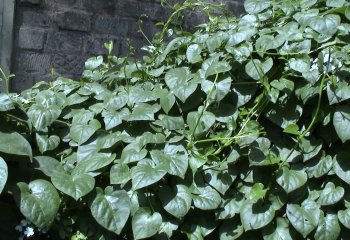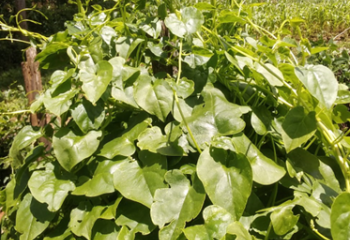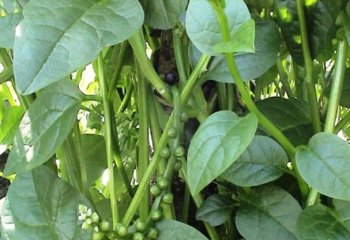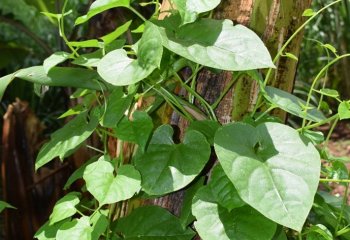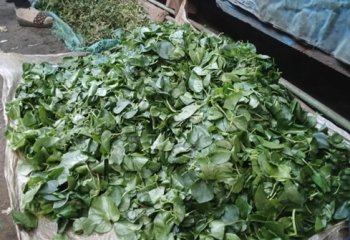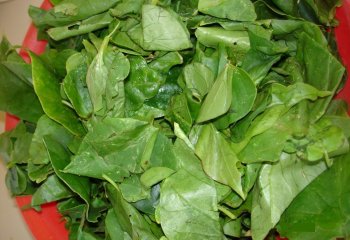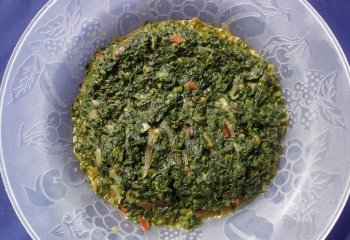Geographical Distribution in Africa
Malabar spinach is considered a native of southern Asia, but its precise place of origin remains unclear. This plant is extensively cultivated in tropical regions and even grown in temperate zones as an annual crop. In tropical Africa, it is prevalent in warm, humid areas but becomes less common in drier or colder regions of the continent. The plant has been documented in numerous countries and is likely present throughout tropical Africa. Native to tropical Africa and Asia. Introduced into most humid tropical countries of the world as an ornamental plant.
Read more
Benin: Abokpaba, Libokpabli (Gourmantché); Tchoosikpékéfa (Waama); Forukpètè (Anii); Yooda (Boko); Yoroukpé (Bariba); Djomankugbédé (Ouémè); Obaléran (Holly); Tokpodéyovoton (Fon), Yovogbomanhuégbé (Cotafon); Yovoglassi (Aïzo) (Achigan et al., 2010)
Burundi: Inderama (Kirundi) (Baerts, M. & J. Lehmann., 1989); Umurerama (Kirundi) (Ngezahayo, J et al., 2015).
Cameroon: Businhi (Fulfuldé); Baselle, Épinard Indien (French)
DRC: Taka Ngola (Kongo); Epinard Indien, Baelle (Fr) (Latham and Konda., 2006); Ndelama (Kinyindu); Nderema (Mashi, Nyindu, Kinande); Ndelama (Lega, Kinyindu)
Ethiopia: Dore (Gedeoffa) (Eshetu, G. R. et al., 2015).
Kenya: Kieema (Kamba); Nderemiat (Keiyo); Murerema (Kikuyu); Nderemiat, Nderemek (Plural) (Kipsigis); Enderema (Kisii); Tsinderema (Luhya); Endelema (Luhya (Bukusu); Eshivetso (Luhya (Kabras); Enderema (Singular) (Luhya (Samia); Yindelema (Luhya (Tachoni); Enderema (Luhya (Tiriki)); Nderma, Demra (Luo); Osoiyai, Osoyai (Maa) ; Nderemia, Okiek: Nderemiat (Marakwet); Rachan (Pokot); Ng'aisichoi, Lemudong'o, Lemoldongu, Ltaai, Ltani (Samburu); Ndelema (Taita); Lubchan (Tugen) (Maundu et al., 1999)
Mauritius: Brède gandolle (A Gurib-Fakim et al.,1994)
Nigeria: Amunututu (Yoruba) (Borokini, et al., 2013).
Rwanda: Indarama (Kinyarwanda) (Desouter, S. 1991)
Tanzania: Inyiri (Chagga); Delega (Luguru); Ndeemo (Sambaa); (Chacha and Laswai., 2020); Lelema (Chagga) (African Museum., 2021); Ndelema (Swahili).
Uganda: Enderema (Rutooro); Nderema (Luganda); Enderema (Rukiga) (Namukobe et al., 2011).
Zaire: Urudega (Kinyarwanda), Nderema (Kihunde), Mboga buterezi (Swahili) (Kasonia, K. & KM Yamolo.,1994)
Introduction.
Basella alba belongs to the Basellaceae family and is often known as Malabar spinach, Indian spinach, Ceylon spinach, and vine spinach. The genus Basella is a group of flowering plants that includes five species. Three of these species are endemic to Madagascar, while one is native to eastern Africa. Two species, Basella alba and Basella alba var. rubra, are widely cultivated for food and ornamental purposes across the tropics. Basella alba is particularly popular as a spinach substitute in many parts of Asia and Africa, while Basella alba var. rubra is grown as an ornamental plant and used in traditional medicine to treat various ailments. This crop is commonly grown in backyard gardens or as a houseplant, but can also be found growing in the wild, particularly in forested or swampy areas. The two distinct species within the Basella genus, B. alba and Basella alba var. rubra, can be differentiated by variations in their leaf characteristics and stem colors. B. alba has dark green leaves and green stems, whereas Basella alba var. rubra features purple stems and dark green leaves with pink veins. As there are no other distinct characteristics to differentiate between these two species, the common names are often used interchangeably.
Malabar spinach is highly valued for its tender young shoots, which are enjoyed as a succulent and slightly mucilaginous vegetable. It can be boiled, used in soups or stews as a potherb, fried in oil, or even used raw in salads. Europeans living in Africa commonly use Malabar spinach as a substitute for spinach, and young tops and seedlings can be used in place of corn salad. The fruit of the plant is useful for dyeing, as the red juice can be used as an ink or cosmetic, and it can also be used to add color to foods. In addition to its culinary uses, Basella spp. has a range of medicinal applications. The young leaves of the plant can serve as a laxative, while the red fruit juice is used as eye drops to treat conjunctivitis. In Africa, the leaves are used to alleviate stomach pains and constipation after childbirth, and crushed leaves are used as a poultice to treat sores. In certain regions of Africa, the plant is given to livestock to increase milk production. Red varieties of B. alba are often grown as ornamental plants and are popular as potted plants in Europe and North America. (Abukutsa-Onyango, M.O., 2004, Maundu et al., 1999).
Ⓒ P. Maundu, 2021
Ⓒ P. Maundu , 2022
Species account
Basella alba is a soft, twining perennial plant with fleshy, green stems that are often tinged brownish-purple. The leaves are heart-shaped with a pointed, soft, shiny, dark green blade that can reach up to 10cm in length. The plant bears small, fleshy, cream or white flowers on an erect inflorescence. The species grows in forests, forests edges, Humid bushland, wet rocks, and cliffs and is common in disturbed areas. Although the information on its invasiveness is not provided, B. alba can grow rampantly in optimal conditions and become invasive if not properly managed in cultivation. Given that the species reproduces efficiently by seeds and vegetatively and develops rapidly, it has a high potential to become invasive in suitable environments. There is a need for further information on the invasiveness and impacts of this species to analyze how it affects habitats and other species and to determine the risk it poses to nations where it is not yet invasive. (Maundu et al., 1999, Vélez-Gavilán J, 2018).
Ⓒ P. Maundu, 2021
@ P. Maundu P, 2022 Vihiga county, western Kenya
Basella alba var. rubra is a perennial herbaceous vine, creeping or climbing up to 10 m. The leaves are green, oval, glossy, and prominently veined. The stems and petioles are beetroot-red to purple and succulent. Flowers are small and insignificant, produced in terminal or axillary spikes. Fruits are one-seeded indehiscent berries with persistent fleshy calyxes, ripening to purplish-black and containing purple juice, falling off readily from the parent plant for self-seeding. The species is related to and differentiated from B alba, which has darker green leaves, green stems, and white flowers (Flora and Fauna web., 2019).
Ecological information
The optimum mean annual temperature for Basella sp is 23 to 27°C, but they can tolerate a temperature range of 10 to 35°C. It does not tolerate frost and requires a minimum daytime temperature of 15°C. It prefers an annual precipitation range of 2000 to 2500 mm but will tolerate 700 to 4200 mm. Even though it is cultivated worldwide up to 2600 m elevation and in tropical, subtropical, and temperate areas, the species will grow best in hot, dry, humid climates and below 500 m elevations. The species prefers well-drained fertile sandy loam soils and full sun to light shade situations. It can grow in soils with a pH range of 5.5 – 7 but can tolerate 4.3 - 7.5. It tolerates poor soils and short periods of drought. It is intolerant to salinity and standing water.
Agronomic aspects
Malabar spinach can be grown as a short-term crop of 2–4 months without support or as a long-term crop grown on fences or trelisses. Propagation of this plant can be achieved through either seeds or cuttings that measure about 20cm long. Short-term crops are commonly planted through direct sowing, as well as the transplantation of seedlings or cuttings.
Planting
To grow from seeds: The seed bed should be tilled to loosen the soil and incorporate compost or well-rotted manure. For direct sowing, seeds may be sown at a rate of 300 seeds per m2 (10 g/m2) in rows spaced 10 cm apart. After 15 days at the cotyledon stage, thin the seedlings to 100 plants per m2. For a long-term crop, sow 3-4 seeds per hole directly into the prepared soil bed in double lines on either side of supports 1.2-1.5 meters high. Space the rows 60 cm apart and the plants 30 cm in the row. A density of 5 plants per m2 is often used for commercial production.
Seedlings can also be grown in containers or seed trays before transplanting. When the seedlings reach a height of 10-15 cm, transplant them to beds with a spacing of 40-50 cm × 40-50 cm or in rows spaced 60-70 cm apart and 25-30 cm between plants. Plants grown from seed are more productive than those grown from cuttings. Water the seedlings regularly and ensure they receive enough sunlight to grow healthy.
To grow from cuttings: Choose healthy cuttings that are at least 20 cm long, with atleast two nodes, and are firm, green, and free from any damage or disease. Prepare the cuttings by removing some of the lower leaves, leaving only one or two leaves at the top, and dip the cut end of the stem into rooting hormone powder to stimulate root growth.
Dig a hole deep enough to hold the cutting and then firm the soil around it to ensure it stands upright. Space the cuttings approximately 25-30 cm apart to give them enough room to grow. Water the cuttings immediately after planting and keep the soil moist but not waterlogged, as watering is essential to keep the cuttings hydrated and promote the growth of roots.
(Abukutsa-Onyango, M.O., 2004)
Husbandry
Malabar spinach is an exceedingly vigorous plant with a climbing habit. To grow the plant effectively, trellising is required to support the vine's climb and spread.
Malabar spinach can be grown in hanging baskets and large containers or trellised and trained to climb on posts, fences, and live support structures as an ornamental plant. Basella sp requires plenty of water in hot, humid climates for proper growth.
Harvest, post harvest practises and markets
Harvesting
After planting, Malabar spinach can be harvested within 30 – 45 days. Tips of branches 15–25 cm long are pinched out weekly for about two months. For a long-term crop, the harvest starts 5–6 weeks after sowing or somewhat earlier if cuttings were used. For transplanted seedlings, Harvesting starts 50–70 days after transplanting. Harvesting continues at regular intervals for up to 6 months when the leaves become too small.
Short-term crop yields up to 40 t/ha in 75 days; for long-term crops, yields are very variable, up to 1.5 kg of shoots or leaves per plant or 80 t/ha in 180 days. Yields of 20–50 t/ha per month of cultivation have been reported.
Post-Harvest
To reduce deterioration, the shoots are tied in bunches. Malabar spinach keeps only one day at temperatures of 20–30°C. For longer storage, the product should be kept in a cool room. The leaves are not usually dried.
Value addition and Market value
Malabar spinach is extensively promoted in numerous regions of Africa and can be found many local markets. In Kenya, Basella alba is grown and consumed mainly by smallholder farmers and is sold in local markets in west Pokot. The vegetable is also gaining popularity among urban consumers in the Nairobi market. In Tanzania, Basella alba is grown and consumed in many country regions and is commonly sold in the local market (Maundu et al., 1999).
@ J. Muia, 2023
Nutritional value and recipes
Malabar spinach is a leafy vegetable highly valued for its high nutritional value and antioxidants. It is a good source of dietary fiber, which aids in digestion, promotes satiety, and supports bowel regularity. The vegetable is also low in calories, making it an excellent choice for weight watchers. Vine spinach is a good source of iron, which is essential for oxygen transport and the prevention of iron deficiency anemia. It also contains calcium, magnesium, potassium, and manganese, which are necessary for various bodily functions, including bone health, muscle function, and electrolyte balance.
Vine spinach is an excellent It is particularly rich in vitamin A, which is important for eye health, immune function, and healthy skin. It also provides significant amounts of vitamin C, an antioxidant that supports immune function, collagen synthesis, and iron absorption. Vine spinach contains vitamin K, which plays a crucial role in blood clotting and bone health.
The plant has been found to have anti-inflammatory, anti-diabetic, and anticancer properties. Daily consumption of Basella positively affects total-body vitamin A stores in men. Furthermore, Basella spp. has a good amount of antioxidants, particularly beta carotene and lutein, naturally occurring chemicals that can help your cells from aging. Comparison of the nutrient content of Basella alba var. rubra and B. alba reveals that these two components have similar nutrient profiles, with some slight differences. B. alba has slightly higher amounts of niacin, ascorbic acid, zinc, sodium, and magnesium, while Basella alba var. rubra has slightly higher amounts of iron and potassium. Both components have similar amounts of copper and calcium.
(AVRDC & IPGRI., 2006, Deshmukh and Gaikwad 2014, Hossain et al., 2016, Kumar et al, 2015).
Table 1: Approximate nutritional content of 100 g of vine spinach leaves
|
Vine (African) spinach, picked leaves, raw |
Vine (African) spinach, picked leaves, boiled, drained (without salt) |
Recommended daily allowance (approx.) for adultsa |
Proximate composition and dietary energy |
|
|
|
Edible conversion factor |
0.94 |
1 |
|
Energy (kJ) |
117 |
123 |
9623 |
Energy (kcal) |
28 |
30 |
2300 |
Water (g) |
90.4 |
89.9 |
2000-3000c |
Protein (g) |
3.4 |
3.6 |
50 |
Fat (g) |
0.7 |
0.7 |
<30 (male), <20 (female)b |
Carbohydrate available (g) |
0.2 |
0.2 |
225 -325g |
Fibre (g) |
3.7 |
3.9 |
30d |
Ash |
1.6 |
1.7 |
|
Mineral composition |
|
|
|
Ca (mg) |
267 |
267 |
800 |
Fe (mg) |
10.9 |
8.6 |
14 |
Mg (mg) |
40 |
25 |
300 |
P (mg) |
56 |
53 |
800 |
K (mg) |
446 |
234 |
4,700f |
Na (mg) |
8 |
6 |
<2300e |
Zn (mg) |
0.5 |
0.36 |
15 |
Se (mcg) |
tr |
0 |
60 |
Bioactive compound composition |
|
|
|
Vit A RAE (mcg) |
184 |
175 |
800 |
Vit A RE (mcg) |
369 |
349 |
800 |
Retinol (mcg) |
0 |
0 |
1000 |
b-carotene equivalent (mcg) |
2210 |
2100 |
600 – 1500g |
Thiamin (mg) |
0.1 |
0.04 |
1.4 |
Riboflavin (mg) |
0.2 |
0.14 |
1.6 |
Niacin (mg) |
0.9 |
0.6 |
18 |
Folate (mcg) |
71.3 |
38 |
400f |
Vit B12 (mcg) |
0 |
0 |
3 |
Vit C (mg) |
79.8 |
34 |
60 |
Source (Nutrient data): FAO/Government of Kenya. 2018. Kenya Food Composition Tables. Nairobi, 254 pp. http://www.fao.org/3/I9120EN/i9120en.pdf
$ Draining the water several times leaches away water soluble nutrients significantly.
a Lewis, J. 2019. Codex nutrient reference values. Rome. FAO and WHO
b NHS (refers to saturated fat)
c https://www.hsph.harvard.edu/nutritionsource/water/
d British Heart Foundation
e FDA
f NIH
Complimentary Recipes
Malabar spinach leaves and young shoots are used to prepare a succulent, slightly mucilaginous vegetable in various communities in africa. It is a versatile vegetable that can be cooked in various ways, including stir-frying, steaming, boiling, and stewing. It is commonly used in soups, stews, sauces, and curries and is often served with staple foods such as rice, maize, or cassava. Nderema should only be lightly cooked. The berries yield a red dye that colors desserts, cakes, and jelly. It is a delicious addition to other greens.
Ⓒ P. Maundu, 2006
a. Nderema in groundnut paste
Ingredients
• 200 g vine spinach leaves
• ½ cup (125 ml) water
• 2 tablespoonfuls of traditional salt
• 2 tablespoonfuls groundnuts (pounded to powder)
• 2 tablespoonfuls or 20 g ghee
• Salt
Preparation
• Remove stalks off the leaves, and then wash the leaves
• Cut them roughly
• Boil the water; add the traditional salt and the vegetables
• Allow cooking for 5-8 minutes, stirring occasionally
• Add the pounded groundnuts, ghee, and salt. Stir
• Serve hot with Ugali
Source; Cookbook for traditional vegetables (IPGRI., 2006). Unpublished
b. Nderema in fresh milk
© IPGRI, 2006
Ingredients
• 200 g of vine spinach
• 1 medium-sized onion (50 g when)
• 2 medium-sized tomatoes (60 g when)
• 2 tablespoonfuls of cooking oil
• Salt to taste
• ½ cup fresh milk
Preparation:
• Remove the stalks off the leaves and wash them leaves
• Heat the oil, add the chopped onions, and fry till they begin to turn golden brown
• Add the vegetables, stir for a minute, then add chopped tomatoes
• Add salt to taste, stir, then add milk and cook for a further 3 minutes
• Serve hot with ugali. (Yields two servings)
Remarks:
Vine spinach is tastier when prepared with traditional salt than when fried. Traditional salt also helps retain the green color of the vegetable even after cooking. Vine spinach generally retains green color than most local vegetables. This vegetable is said to give relief to individuals suffering from stomach ulcers.
Source: Cookbook for traditional vegetables (IPGRI., 2006). Unpublished.
c. Mangalorean Malabar spinach curry recipe
ingredient
• ¾ cup black-eyed beans/lobia/chawli
• 1 to 1.5 cups chopped Malabar spinach leaves and stems
• ¾ cup to 1 cup fresh grated coconut/nariyal
• 1 tbsp oil
• 1 small onion/pyaaz
• 1 medium tomato/tamatar
• 3 to 4 garlic/lahsun
• 1 tsp mustard seeds/rai
• a pinch of asafoetida/hing
• salt as required
• For dry roasting the spices
• 3 tsp coriander seeds/sabut dhania
• 2 tsp cumin/sabut jeera
• 3-4 black peppercorns/sabut kali mirch
• ¼ tsp fenugreek seeds/methi dana
• 2 to 3 dry red chillies/
Cooking procedure
• Rinse and soak the black-eyed beans or chawli/lobia in enough water overnight or for 5 to 6 hours.
• Drain them and pressure cook the black-eyed beans in 2 or 2.5 cups water, along with salt, till they are cooked well and softened. They should not become mushy.
• Heat a small skillet or pan. Add all the whole spices and, on low heat, dry roast them till aromatic.
• When the spices cool, add them to a grinder along with grated coconut.
• Add some water and make a smooth paste of the roasted spices with the coconut.
• Keep the coconut spices paste aside.
• Lightly crush garlic in a mortar-pestle keeping the peels on it and just crushing them lightly, not making a paste of them.
• Finely chop the onions and dice the tomatoes.
• Rinse and remove the leaves from the stems of the Malabar spinach. Small leaves can be kept intact. Large leaves can be chopped.
• Cut the tender stems into one or 1.5-inch pieces. If the stems are not tender, you must cook them separately in water in a pan or pressure cooker until they are cooked well.
• Heat oil in a pan. Crackle the mustard first.
• Then add the crushed garlic with their peels. saute for 4-5 seconds
• Add onions and saute till translucent. add the tomatoes and coconut spice paste
• Stir and saute for 2 to 3 minutes.
• Add the Malabar spinach leaves and stems.
• Stir and add 1 to 1.5 cups of stock or water. Season with salt and stir again.
• Simmer the curry for 6-7 minutes on a low to medium flame.
• Add the cooked black-eyed beans and simmer for 6-7 minutes or more, till all the flavors are well blended. You will see specks of oil on top of the curry when it's done.
• If the curry looks thick, add water if required, and continue to simmer.
• The curry is neither thick nor thin but of medium consistency.
• Lastly, garnish the curry with chopped coriander leaves if you prefer.
Serve the Malabar spinach curry hot with steamed rice and chapattis.
Source: Cookbook for traditional vegetables (IPGRI., 2006). Unpublished
Information on Pests.
a. Cotton Bollworm
Any larvae of various moths (Order Lepidoptera), including the pink bollworm (Pectinophora gossypiella, family Gelechiidae), and some Helicoverpa species.
What to do
• Bollworm pests can be managed using biological control methods, such as natural parasites, or through early crop planting and trap crops (Britannica., 2018).
b. Beet armyworm
Beet armyworms (Spodoptera exigua) are green caterpillars that feed on various ornamental and vegetable plants. The young larvae feed in groups and usually don't have any unique markings to distinguish them from other caterpillars. However, older larvae develop a yellow stripe that runs from head to tail, making it easy to identify them. Detecting and treating a beet armyworm infestation early is essential because these older caterpillars resist most insecticides. They are commonly found only in southern states and warm, coastal climates where the host plants survive through the winter .
Beet armyworms (Spodoptera exigua) feeds on a variety of ornamental and vegetable plants. In their early stages, these larvae tend to feed in groups and lack any distinguishing features. As they mature, however, a yellow stripe appears that runs from their head to their tail, allowing for easy identification. It is crucial to detect and address infestation promptly as older caterpillars are often resistant to most insecticides.
Damage description
Beet armyworms eat irregular holes in foliage, eventually skeletonizing the leaves. They can eat tender young transplants to the ground and defoliate older plants .
What to do
• Handpicking the caterpillar and dropping them into a container of soap and water to kill them and then bag and discard them
• Bacillus thuringiensis (Bt-azaiwi strain) and spinosad are natural insecticides that are effective against young armyworms and don't harm the environment.
• These caterpillars resist most chemical insecticides available to the home gardener, but neem oil products are sometimes effective. The eggs, covered by a cottony or fibrous mass, are susceptible to treatment with petroleum oils. (Jackie carroll., 2021)
c. Flea beetles
Flea beetles are small, shiny black beetles that measure approximately one-tenth of an inch in length. They possess disproportionately large hind legs that enable them to jump. Certain species of flea beetles feature distinctive yellow or white markings on their bodies. These pests comprise a diverse species of beetles with varying feeding habits. While some species feed on a broad range of plants, others solely target specific plant families.
Damage description
Adult fleas create shallow pits and small, irregularly shaped holes in the leaves, typically measuring less than 1/8th of an inch. This type of damage is a common indicator of flea beetle activity. Plants started from seeds are less tolerant of feeding damage compared to transplants, but both can be severely injured if flea beetle numbers are high.
What to do
• Place yellow sticky traps in your garden to see if you have flea beetles.
• Check your plants for flea beetles and their damage. (Mike and McKenney., 2020)
Information on diseases.
There is limited information available on the susceptibility of Malabar spinach to diseases. However, it is important to note that like any other plant, Malabar spinach is vulnerable to a variety of diseases caused by fungal, bacterial, and viral pathogens. Some of the commonly reported diseases affecting Malabar spinach include leaf spots caused by Colletotrichum sp, powdery mildew caused by Erysiphe polygoni, and bacterial leaf spots caused by Xanthomonas campestris. To prevent these diseases, it is important to maintain proper plant spacing, ensure good air circulation, and provide adequate drainage. Disease-resistant cultivars may also be available, and organic and chemical controls may be necessary in severe cases.
References and information links
References
- Abukutsa-Onyango, M.O., 2004. Basella alba L. [Internet] Record from PROTA4U. Grubben, G.J.H. & Denton, O.A. (Editors). PROTA (Plant Resources of Tropical Africa / Ressources végétales de l’Afrique tropicale), Wageningen, Netherlands. <http://www.prota4u.org/search.asp>. Accessed 3 March 2022.
- Achigan‐Dako, E.G., Pasquini M.W., Assogba‐Komlan F., N’danikou S.,Yédomonhan H., Dansi A., Ambrose‐Oji B. 2010. Traditional vegetables in Benin.Institut National des Recherches Agricoles du Bénin. Imprimeries du CENAP,Cotonou.
- Basella alba L. in GBIF Secretariat (2021). GBIF Backbone Taxonomy. Checklist dataset https://doi.org/10.15468/39omei accessed via GBIF.org on 2022-10-23.
- Basella rubra L. in GBIF Secretariat (2021). GBIF Backbone Taxonomy. Checklist dataset https://doi.org/10.15468/39omei accessed via GBIF.org on 2022-10-23.
- James S. Chacha and Henry S. Laswai. 2020. Traditional Practices and Consumer Habits regarding Consumption of Underutilized Vegetables in Kilimanjaro and Morogoro Regions, Tanzania. International Journal of Food Science (Vol 2020) Article ID 3529434, 10 pages https://doi.org/10.1155/2020/3529434
- Latham, P. and Konda Ku Mbuta, A.K. (2006) Useful Plants of Bas-Congo Province, Democratic Republic of Congo. 2nd Edition, Mystole Publications, Canterbury, 276.
- Adhikari, R., & Kumar, N. H. (2012). A Review on Medicinal Importance of Basella alba L. International Journal of Pharmaceutical Sciences and Drug Research, 4(2), 110114
- AVRDC & IPGRI, 2006.African Leafy vegetables. Markets and Gardening practises. Unpublished.
- Britannica, T. Editors of Encyclopaedia (2018, February 19). bollworm. Encyclopedia Britannica. https://www.britannica.com/animal/bollworm
- Chagomoka T, Kamga R, Tenkouano A, Mecozzi M. 2014. Traditional Vegetables: Recipes from Cameroon. AVRDC – The World Vegetable Center. Shanhua, Taiwan. Publication 14-779. 57 p
- Deshmukh, S. A., & Gaikwad, D. K. (2014). A review of the taxonomy, ethnobotany, phytochemistry, and pharmacology of Basella alba (Basellaceae). Journal of Applied Pharmaceutical Science, 4(1), 153–165. https://doi.org/10.7324/JAPS.2014.40125
- Flora and Fauna web, 2019.Basella rubra. https://www.nparks.gov.sg/florafaunaweb/flora/1/3/1322
- IPGRI 2006.Cookbook for traditional vegetables Unpublished.
- Jackie carroll (2021, July,02) Beet Armyworm Control: Information On Treating And Preventing Armyworms. Gardeningknowhow https://www.gardeningknowhow.com/edible/vegetables/beets/beet-armyworm-control.htm/?print=1&loc=bot
- Lock, M., Grubben, G. J. H., & Denton, O. A. (2004). Plant Resources of Tropical Africa 2. Vegetables. In Kew Bulletin (Vol. 59, Issue 4). https://doi.org/10.2307/4110929
- Mike and Dorothy McKenney(2020,April 23) The Flea Beetle: An Enemy to Many of Your Vegetables. Dengarden . https://dengarden.com/gardening/The-Flea-Beetle-An-Enemy-to-Many-of-Your-Vegetables
- Natalie P. Goldberg and Jason M.(2016). Tomato Spotted Wilt Virus French(https://aces.nmsu.edu/pubs/_h/H242/welcome.html
- Patrick M. Maundu, Grace W. Ngugi, and Christine H.S. Kabuye, Traditional Food Plants of Kenya, Kenya Resource Centre for Indigenous Knowledge, National Museums of Kenya, Nairobi, Kenya, 1999, p. 106.
- Patrick Maundu, 2007. Malawi vegetables list. Unpublished
- Patrick Maundu.2015. Species food list Kamashi, Ethiopia. Unpublished.
- Sipika Swati, Prateek Agarwal.(2015) A Critical Review of Potaki (Basella Alba) in Ayurvedic Texts with Recent Studies. AYUSHDHARA, 2015;2(3):194-198. https://core.ac.uk/download/pdf/333809511.pdf
- Vélez-Gavilán J, (2018). Basella alba (malabar spinach). Invasive Species Compendium. Wallingford, UK: CABI. DOI:10.1079/ISC.8273.20203483150. Basella alba (malabar spinach) (cabi.org)
Information links
•Https://herbsfromdistantlands.blogspot.com/search?q=basella+alba
•1174_pdf.pdf (japsonline.com)
•364-1401974410.pdf (oaji.net)
•basella alba - useful tropical plants (theferns.info)
•basella alba (malabar spinach) (cabi.org)
•basella alba (malabar spinach) (cabi.org)
•basella alba (prota4u.org)
•basella alba | leaves | wild edible plants | teri wrc | digital library (teriin.org)
•basella alba | malabar spinach | indian spinach - green cover initiative
•basella alba: biodiversity for food and nutrition (b4fn.org)
•controlling and identifying beet armyworm damage (gardeningknowhow.com)
•flea beetles: how to get rid of flea beetles in your garden | the old farmer's almanac
•Http://herbsfromdistantlands.blogspot.com/2015/05/basella-alba-basella-rubra-malabar.html#:~:text=it%20appears%20in%20two%20forms,stems%20and%20veins%20of%20leaves.
•https://www.britannica.com/animal/bollworm).
•list of nigeria vegetables (medianigeria.com)
•the flea beetle: an enemy to many of your vegetables - dengarden
Review Process
Dr. Patrick Maundu, James Kioko, Charei Munene and Monique Hunziker, January 2024

